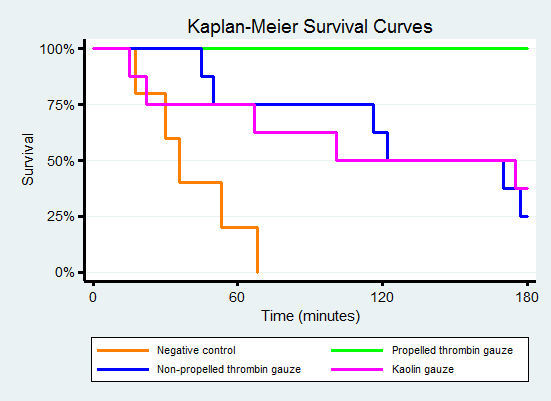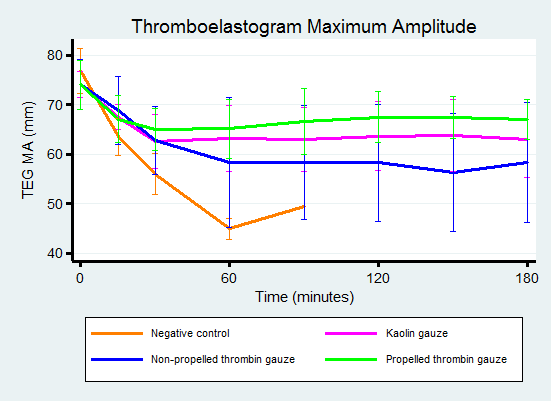Gauze with self-propelling microparticles containing thrombin and tranexamic acid drastically improved survival in a swine model of lethal hemorrhage
-
1
University of Washington, Emergency Medicine, United States
-
2
University of British Columbia, Michael Smith Laboratories, Canada
Introduction: Severe bleeding from large arterial wounds is a leading cause of death after trauma. Hemostatic gauzes containing coagulation activators are currently used to pack and compress wounds but are less effective in anatomical locations where compression cannot be performed, likely because their activators are pushed away from the site of vessel injury by the hemorrhaging blood. Gauze impregnated with self-propelling microparticles that disperse hemostatic activators throughout the wound, including upstream against hemorrhage flow, may be useful in these situations.
Methods: A self-propelling hemostatic bandage was created by binding thrombin to calcium carbonate microparticles and coating these particles on cotton bandage in the presence of solid protonated tranexamic acid (TXA). Contact with blood causes brisk release of CO2 and propulsion of microparticles against flowing blood to deliver the thrombin and induce hemostasis. Non-protonated TXA was substituted to form a non-propelling control. Bleeding was induced in 29 immature female swine using a 5 mm femoral arteriotomy. Pigs were randomized into 1 of 4 packing interventions without wound compression: negative control, kaolin hemostatic gauze control (Combat Gauze™) (KG), propelled thrombin gauze (PTG), or non-propelled thrombin gauze control (NPTG). All animals then received intravenous fluids to restore blood pressure for up to 3 hours. Survival was compared using Kaplan-Meier log rank, and continuous variables (i.e., blood loss and laboratory values) were compared using repeated measures ANOVA.
Results: Survival was improved with PTG (3-hr survival: 8/8, 100%) compared to KG (3/8, 37.5%, p=0.01) and compared to NPTG (2/8, 25.0%, p=0.01).

Total and post-intervention external blood loss were similar in all gauze groups (p>0.05). Thromboelastogram maximum amplitude was higher with PTG compared to NPTG at 150 minutes but was otherwise not significantly different.

Fibrinogen concentration did not differ across groups.
Discussion: Propelled thrombin gauze improved survival in this lethal bleeding model. Self-propelling particles could be used to deliver a number of pro-thrombotic or wound-healing agents throughout an actively hemorrhaging wound to promote hemostasis and recovery.
Keywords:
Drug delivery,
biomaterial,
medical application,
Bioactive molecule
Conference:
10th World Biomaterials Congress, Montréal, Canada, 17 May - 22 May, 2016.
Presentation Type:
Poster
Topic:
Biomaterials in thrombosis and hemostasis
Citation:
St. John
A,
Baylis
JR,
Wang
X,
Lim
EB,
Statz
ML,
Chien
D,
Stern
SA,
Kastrup
CJ and
White
NJ
(2016). Gauze with self-propelling microparticles containing thrombin and tranexamic acid drastically improved survival in a swine model of lethal hemorrhage.
Front. Bioeng. Biotechnol.
Conference Abstract:
10th World Biomaterials Congress.
doi: 10.3389/conf.FBIOE.2016.01.02418
Copyright:
The abstracts in this collection have not been subject to any Frontiers peer review or checks, and are not endorsed by Frontiers.
They are made available through the Frontiers publishing platform as a service to conference organizers and presenters.
The copyright in the individual abstracts is owned by the author of each abstract or his/her employer unless otherwise stated.
Each abstract, as well as the collection of abstracts, are published under a Creative Commons CC-BY 4.0 (attribution) licence (https://creativecommons.org/licenses/by/4.0/) and may thus be reproduced, translated, adapted and be the subject of derivative works provided the authors and Frontiers are attributed.
For Frontiers’ terms and conditions please see https://www.frontiersin.org/legal/terms-and-conditions.
Received:
27 Mar 2016;
Published Online:
30 Mar 2016.